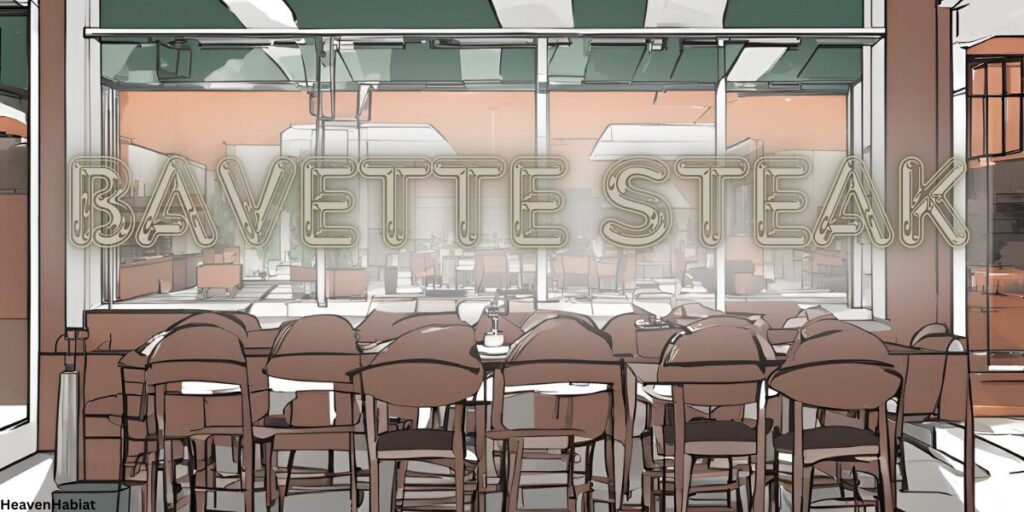Bavette Steak: The Underrated Steakhouse Star

Welcome to your one-stop shop for all things bavette steak! Often overshadowed by its flashier counterparts, bavette is a cut with exceptional potential for a delicious and satisfying steakhouse experience at home. This guide dives deep into the world of bavette, equipping you with the knowledge and techniques to transform this cut into a succulent star of your next meal.
Contents
- 1 From Cow to Plate: Unveiling the Bavette
- 2 Flavor Profile: A Symphony of Beefy Goodness
- 3 The Science Behind the Sizzle: Marbling Matters
- 4 Bavette Steak Mastery: Selecting, Prepping & Cooking
- 5 Cooking Techniques: Unleash Your Inner Grill Master
- 6 Bavette Steak: Beyond the Plate
- 7 Bavette Steak Pairings: The Art of Accompaniment
- 8 Bavette vs. The Rest: A Showdown
- 9 Bavette: A Budget-Friendly Alternative?
- 10 Conclusion: Your Bavette Steak Journey Begins Now
From Cow to Plate: Unveiling the Bavette
Bavette steak, also known as flank steak flap or sirloin flap steak, originates from the beef chuck primal cut. Specifically, it comes from the cow’s underside, situated between the flank and the rib. This hardworking muscle translates to a steak with a distinct character. Unlike filet mignon’s tenderness or ribeye’s rich marbling, bavette boasts a beautiful balance.
Flavor Profile: A Symphony of Beefy Goodness
The bavette’s flavor profile is a symphony for beef lovers. It delivers a robust, full-bodied taste that’s undeniably meaty. While not as buttery as a ribeye, bavette possesses a subtle hint of sweetness that keeps things interesting. The pronounced beefiness pairs wonderfully with bold seasonings and sauces, making it a versatile blank canvas for culinary creativity.
The Science Behind the Sizzle: Marbling Matters
Marbling, the intricate web of fat strands within muscle tissue, plays a crucial role in a steak’s flavor and texture. Bavette, by nature, has less marbling compared to ribeye or New York strip. However, this doesn’t equate to dryness. The bavette’s tight muscle fibers retain moisture exceptionally well, resulting in a juicy eating experience despite the leaner profile.
Bavette Steak Mastery: Selecting, Prepping & Cooking
Now that you’re familiar with bavette’s unique characteristics, let’s explore how to transform it into a restaurant-worthy dish.
Choosing the Perfect Bavette:
Visual Inspection: Look for a steak with a vibrant red hue, indicating freshness. Avoid steaks with dull or brownish tones.
The Feel Factor: Give the bavette a gentle squeeze. It should be firm but slightly yield to pressure, not mushy or rock-hard.
Size Matters: Bavette steaks typically range from 1 to 2 pounds. Choose a size suitable for the number of people you’re serving, considering leftovers for creative dishes (we’ll get to that later!).
Prepping Like a Pro:
Bavette benefits from some pre-cooking preparation to enhance its tenderness and unlock its full flavor potential. Here are two popular methods:
Marinades: Marinades are a flavorful way to tenderize bavette. Acidic ingredients like citrus juice or vinegar help break down muscle fibers, while herbs and spices infuse the steak with delicious aromas. Marinate your bavette for at least 2 hours, or ideally overnight, for maximum impact.
Dry-Brining: Dry-brining is a technique that utilizes salt to draw out moisture and redistribute it throughout the meat, resulting in a more concentrated beef flavor and improved texture. Generously coat your bavette with kosher salt and refrigerate, uncovered, for 24 to 48 hours before cooking.
Cooking Techniques: Unleash Your Inner Grill Master
Bavette’s versatility shines through various cooking methods. Here are three popular approaches to achieve mouthwatering results:
Pan-Seared Perfection:
Heat a cast-iron skillet over high heat until smoking. Sear the bavette for a few minutes per side to develop a beautiful crust. Reduce heat and cook to your desired doneness, using a meat thermometer for accuracy (see recommended internal temperatures below).
Grilled Goodness:
Preheat your grill to high heat. Sear the bavette for a nice char and then adjust the heat to indirect grilling for even cooking.
Sous Vide: The Precision Approach:
Sous vide, a method of cooking food in a precisely temperature-controlled water bath, allows for perfectly cooked bavette every time. Season your steak, seal it in a vacuum bag, and cook in a sous vide water bath at 130°F (54°C) for 1-2 hours for a medium-rare doneness. Sear the cooked steak briefly in a hot pan for a final sear.
Bavette Steak: Beyond the Plate
Bavette’s culinary potential extends far beyond the classic steak dinner. Here are some ideas to elevate your leftover steak game:
Bavette Steak Salad: Thinly sliced bavette adds a protein punch to a salad. Toss with mixed greens, cherry tomatoes, crumbled blue cheese, and a vinaigrette for a satisfying lunch or light dinner.
Fajita Fiesta: Thinly slice cooked bavette and marinate in fajita seasoning. Sauté with peppers and onions, and serve with warm tortillas
Bavette Steak Pairings: The Art of Accompaniment
Just like a great supporting actor elevates a movie, the right side dishes and sauces can take your bavette steak experience to the next level.
Flavorful Friends: Side Dishes for Every Palate
Classic Companions: For a timeless pairing, consider roasted vegetables like asparagus, Brussels sprouts, or root vegetables. These options complement the robust flavor of bavette without overwhelming it.
Starchy Delights: Mashed potatoes, creamy polenta, or even crispy French fries provide a comforting and textural contrast to the bavette.
A Touch of Green: Balance the richness with a simple green salad dressed with a light vinaigrette. Leafy greens like arugula or spinach add a refreshing counterpoint.
Saucesational: Adding Flavor Layers
Bavette’s inherent versatility allows for a variety of sauces to enhance its flavor profile. Here are a few suggestions:
Chimichurri: This Argentinian sauce, made with parsley, garlic, olive oil, and vinegar, adds a bright and herbaceous touch.
Blue Cheese Sauce: Creamy and slightly sharp, blue cheese sauce creates a luxurious contrast with the meaty bavette.
Peppercorn Sauce: For a touch of heat and complexity, try a creamy peppercorn sauce made with green or black peppercorns.
Dietary Considerations:
Keto-Friendly: Pair your bavette with roasted cauliflower rice or grilled zucchini for a satisfying low-carb meal.
Gluten-Free: Opt for gluten-free sides like roasted sweet potato fries or a simple salad with a vinaigrette dressing.
Bavette vs. The Rest: A Showdown
Often confused with its neighbor, flank steak, bavette offers a distinct eating experience. Let’s break down the key differences:
Location, Location, Location: Flank steak comes from the cow’s abdominal area, while bavette originates from the underside of the chuck primal.
Texture Talk: Flank steak has a coarser grain and requires careful preparation to achieve tenderness. Bavette, with its finer muscle fibers, is naturally more tender.
Flavor Fiesta: Both steaks boast a pronounced beefy flavor. However, bavette tends to be slightly more nuanced, with a hint of sweetness compared to flank steak’s bolder profile.
Bavette: A Budget-Friendly Alternative?
Bavette generally falls on the more affordable end of the steak spectrum compared to prime cuts like ribeye or New York strip. This makes it an excellent choice for a delicious and budget-conscious steak dinner. However, keep in mind that bavette might require slightly more preparation for optimal tenderness. When considering value, weigh the lower price point against the potential need for marinating or dry-brining.
Conclusion: Your Bavette Steak Journey Begins Now
We’ve explored the fascinating world of bavette steak, from its origins to cooking techniques and beyond. With its robust flavor, affordability, and versatility, bavette is a cut that deserves a prominent place in your steakhouse repertoire. So, fire up your grill, preheat your pan, or get your sous vide water bath ready – it’s time to experience the magic of bavette!
Have you tried cooking bavette steak? Share your favorite preparation method and pairing in the comments below! We’d love to hear from you.
Bavette steak tends to be on the thinner side. To ensure even cooking and prevent overdone meat, consider using a reverse sear method. This involves slowly roasting the steak in the oven at a low temperature until it reaches an internal temperature 10°F (5°C) below your desired doneness. Then, sear the steak in a hot pan to achieve a beautiful crust.









1 thought on “Bavette Steak: The Underrated Steakhouse Star”